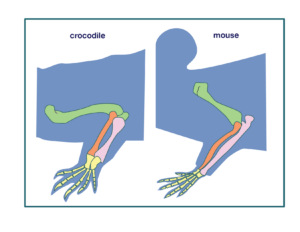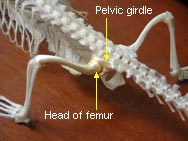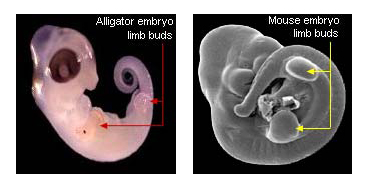Biologists use a few criteria to help them decide whether a shared morphological character (such as the presence of four limbs) is likely to be a homology:
 Same basic structure. The same bones (though differently shaped) support the limbs of mice and crocodiles. In the illustration of forelimbs at left, homologous bones are colored alike.
Same basic structure. The same bones (though differently shaped) support the limbs of mice and crocodiles. In the illustration of forelimbs at left, homologous bones are colored alike.-

Image courtesy of Dave Smith, UCMP Same relationship to other features.The limb bones are connected to the skeleton in similar ways in different tetrapods. The joint between the femur and the pelvis has a ball-and-socket structure which is typical of tetrapods, as shown in the crocodile to the left.
- Same development.The limbs of all tetrapods develop from limb buds in similar ways (see below).

These criteria help biologists tentatively identify homologous morphological characters that are likely to be reliable indicators of shared ancestry.
Read more about the criteria used in recognizing homologies, how phylogenies are constructed using parsimony, and how phylogenies can be used to understand history.
Teach your students about homologies and analogies:
- Similarities and differences: Understanding homology and analogy, a web activity for grades 6-8.
- Similarities and differences: Understanding homology and analogy, a web activity for grades 9-12.
Find additional lessons, activities, videos, and articles that focus on homologies.
